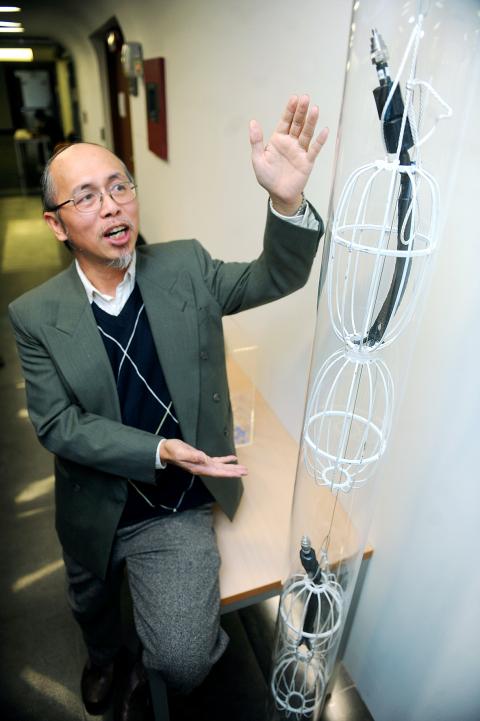Taiwanese researchers will collaborate with their counterparts in several countries to launch the world’s largest neutrino observatory in Antarctica in four years, a project that could help scientists better understand the origin of the universe, researchers said yesterday.
The NT$240 million (US$7.9 million) observatory, which will cover an area of 100km2, will involve universities in the US, Europe, Japan and Taiwan.
When completed, it will be much larger than the IceCube observatory, currently the largest neutrino detector in the world, with an area of 1km2.

Photo: Liao Chen-huei, Taipei Times
This means that the new observatory will have a detection capacity 200 times that of the IceCube, the Taiwanese team said at a press conference in Taipei.
“The observatory will enable scientists to detect higher-energy neutrinos from distant galaxies,” said Huang Ming-huey (黃明輝), a professor and member of the research team, which has about 10 associates.
“These neutrinos can tell us what happened in the early universe and help us understand how the universe came into being,” he said.
Unlike the particles that make up light, radio waves and X-rays, neutrinos can penetrate anything, making them ideal for the observation of distant areas of the universe, Huang said.
Radio antennas are buried 200m deep in the Antarctic ice sheet at an elevation of 3,000m to measure the radio frequency of radiation emitted during the interaction of the neutrinos deep in the ice sheet.
The Taiwanese team, led by Chen Pi-sin (陳丕燊) from National Taiwan University (NTU), will provide 10 of the 37 antenna stations that will form the hexagonal observatory and will be responsible for the design and production of the antenna detectors.
The installation of the first station began early this month, with six more expected to be completed within the next two years by the Taiwanese team, Huang said.
Chen, who is currently in Antarctica taking part in the installation of the station, told the media through a video conference that the project was being carried out at the Antarctic “because the ice here is 3,000m thick.”
He said ice is an ideal medium for the detection of neutrinos.
However, he said the extremely cold weather has been the biggest challenge for the researchers.
After the observatory is completed, the team will spend at least five to 10 years collecting data, Chen said.
“We hope to make some discoveries,” he added.
The Askaryan Radio Array observatory project began in 2009. Taiwan’s government-operated National Science Council and NTU’s Leung Center for Cosmology and Particle Astrophysics are co-funding the Taiwanese contribution.
The Leung Center for Cosmology and Particle Astrophysics was established in 2007 by a donation of NT$205 million from C.C. Leung (梁次震), founder and vice chairman of Quanta Computer Inc (廣達電腦), the world’s largest contract notebook PC maker.
Leung was Chen’s classmate in the NTU physics department. While a student at NTU, Leung set up an astronomy club with his classmates because of his strong interest in astrophysics and high energy physics.

The US dollar was trading at NT$29.7 at 10am today on the Taipei Foreign Exchange, as the New Taiwan dollar gained NT$1.364 from the previous close last week. The NT dollar continued to rise today, after surging 3.07 percent on Friday. After opening at NT$30.91, the NT dollar gained more than NT$1 in just 15 minutes, briefly passing the NT$30 mark. Before the US Department of the Treasury's semi-annual currency report came out, expectations that the NT dollar would keep rising were already building. The NT dollar on Friday closed at NT$31.064, up by NT$0.953 — a 3.07 percent single-day gain. Today,

‘SHORT TERM’: The local currency would likely remain strong in the near term, driven by anticipated US trade pressure, capital inflows and expectations of a US Fed rate cut The US dollar is expected to fall below NT$30 in the near term, as traders anticipate increased pressure from Washington for Taiwan to allow the New Taiwan dollar to appreciate, Cathay United Bank (國泰世華銀行) chief economist Lin Chi-chao (林啟超) said. Following a sharp drop in the greenback against the NT dollar on Friday, Lin told the Central News Agency that the local currency is likely to remain strong in the short term, driven in part by market psychology surrounding anticipated US policy pressure. On Friday, the US dollar fell NT$0.953, or 3.07 percent, closing at NT$31.064 — its lowest level since Jan.

Hong Kong authorities ramped up sales of the local dollar as the greenback’s slide threatened the foreign-exchange peg. The Hong Kong Monetary Authority (HKMA) sold a record HK$60.5 billion (US$7.8 billion) of the city’s currency, according to an alert sent on its Bloomberg page yesterday in Asia, after it tested the upper end of its trading band. That added to the HK$56.1 billion of sales versus the greenback since Friday. The rapid intervention signals efforts from the city’s authorities to limit the local currency’s moves within its HK$7.75 to HK$7.85 per US dollar trading band. Heavy sales of the local dollar by

The Financial Supervisory Commission (FSC) yesterday met with some of the nation’s largest insurance companies as a skyrocketing New Taiwan dollar piles pressure on their hundreds of billions of dollars in US bond investments. The commission has asked some life insurance firms, among the biggest Asian holders of US debt, to discuss how the rapidly strengthening NT dollar has impacted their operations, people familiar with the matter said. The meeting took place as the NT dollar jumped as much as 5 percent yesterday, its biggest intraday gain in more than three decades. The local currency surged as exporters rushed to